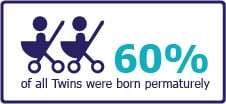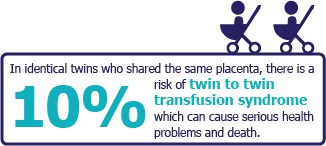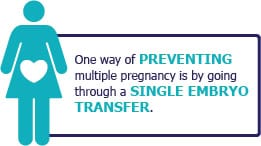07 August 2015
•5 minute read
One is Nice, Two is Fun and Three is Crowded!
Having twins or multiple pregnancy seems to be the desire of most couples who undergone fertility treatment.
After all, most of us know normal, healthy twins, or read newspaper articles of families who are delighted with their twins or triplets following IVF treatment.
“Oh, I wish I had twins, I hope I have twins, why not have two at a time? “ pleading to their doctors.
What could be better than completing your family in one go, with twins or even more babies?
However the reality is that for many twins and triplets, life can be fragile and difficult.
Reproductive specialists are always being pressured by couples to put in more than 2 embryos during their IVF treatment. Putting in more embryos would result in higher pregnancy rate but the rate of higher order multiples such as twins and triplets also increases.
At present, about 1 in 4 IVF pregnancies lead to a multiple birth. This means that after IVF/ICSI, you are around 20 times more likely to have a multiple pregnancy than you would be if you have conceived naturally.
Women should understand that the human womb was created for just one baby.
Having two is fun but three is a crowd for a small womb.
Yes, we do understand that having twins or multiples are fun, but it is not without risks.
Compared to having one baby, twins and other multiples are more likely to have serious and even life threatening health problems.
The risks may involve both the mother and baby.
It can cause early or late miscarriage more than singleton. As a result of the miscarriage due to the twins occupying larger area of the uterus, it may results in heavy bleeding following the miscarriage. Most women with twins will end up with surgical procedure to evacuate the remaining tissues left in the uterus after a miscarriage.
Medical condition risks such as gestational diabetes and pregnancy induced hypertension tend to be higher in women with multiple pregnancies. Women with gestational diabetes will have the risk of sudden intra uterine death which can be devastating to women who has been waiting long to get pregnant.
Twins are five times more likely than single-birth babies to die within a month of birth. There are many reasons for this which includes being born prematurely i.e. born before the actual expected time, small size of the baby (low birth weight) and possibly birth defects which include cerebral palsy. Cerebral palsy is more likely found in premature babies.

Twins and other multiples are much more likely than single babies to be born early. According to statistics from the UK, 60% of all twins were born prematurely, compared to 11% of single babies. And 12% of these twins were born very prematurely i.e. before 32 weeks of gestation, compared to about 2% of single babies. Singleton babies are usually carried for about 40 weeks and tend to have normal birth weights.
At least half of twins are born before 37 weeks and with low birth weights, making them at high risk of serious health problems and death. Many are born before 35 weeks, when they often need neonatal care. Their birth weight is around 800–1000g less than singletons. Low birth weight may also results in hearing or vision loss.
Twins also have higher risk of anemia or low hemoglobin during pregnancy. Hemoglobin carries oxygen, and if the oxygen is low, it will affect the growth of the baby in the womb. The women will also have a higher risk of bleeding following delivery. Bleeding can also takes place before delivery.
Emotional risk tends to be higher in those with twins. It can be costly emotional roller coaster to go through IVF treatment but having premature babies can add to the psychological burden. Hence their post natal recovery can be slow leading to postnatal depression or post natal blues.
During birth, mothers of twins are more likely to require intervention, more likely to experience serious problems and more likely to die than mothers of singletons.
Caesarean is common among twin births. Most women would request for Caesarean as generally they would not like to go through the risk of normal labor .Other reasons as to why Caesarean increases is because of higher risk of placenta praevia(low lying placenta), malposition of the first twins such as breech and the presence of medical conditions such as gestational diabetes and pregnancy induced hypertension.
Screening for chromosomal anomalies such as Down’s syndrome can be difficult and challenging for obstetricians.
Screening is usually done by scan to check for the baby’s nasal bone and the thickness of the skin around the neck at around 11 to 13 weeks. At 14 to 18 weeks, screening can also be done using maternal blood. However interpretation of results usually tends to be difficult. For women who need further investigation such as amniocentesis, the risk of miscarriage is very much higher due to the procedure. The women may also face with ethical dilemma if only one of the twins is having Down’s Syndrome and the other twins is healthy. Terminating the Down’s Syndrome baby can also lead to miscarriage of the normal baby.

In identical twins who shared the same placenta, there is a 10% risk of twin to twin transfusion syndrome which can cause serious health problems and death. In this syndrome one of the babies received enough oxygen from the umbilical cord and the other one is being deprived of oxygen. The baby receiving less oxygen is because of less blood goes to the baby. This problem does not occur in non identical twins.
Women with twins or multiples especially first time parents should also consider the potential problem of bringing up twins in relation to financial burden, difficulty in breast feeding and the psychological impact. These issues could lead to long term impact to the couple leading to separation of family in the future which is often overlooked. These affect life with twins not just as babies but as they get older as well. Dividing care and attention between two children can be unexpectedly difficult.
If women have twins or multiples, it is not the end of the world for you. You will need to have more checks with their obstetrician throughout the pregnancy. Even though the obstetric performance of twin women tends to be difficult, most of the time your obstetrician can manage and guide you to a healthy pregnancy resulting in healthy twins. For those with triplets or more you have the option of fetal reduction. This involves aborting one or more of the fetuses resulting in singleton or twins pregnancy. However this procedure is not without risks. It may cause miscarriage of all the fetuses.

One way of preventing multiple pregnancy is by going through a single embryo transfer. Surely by putting in one embryo can result in lower pregnancy rate. This disadvantage can be overcome by putting in a day 5 embryo called blastocyst instead of day 2 or day 3 embryos. The success rate of pregnancy following a single blastocyst transfer is always higher than a day 2 or day 3 embryos.
Multiple pregnancies can also lead to higher cost for health care provider. Twin pregnancies can cause tax payers millions of ringgit per year. This is due to increase hospitalization to prevent premature births, increase in intensive care for babies born prematurely and increase risk of lifelong disabilities like cerebral palsy in multiples.
Having multiples can be fun but understanding the risks is very important before you embark on IVF treatment. It is my hope that this article will guide you on deciding the number of embryos to be put into your womb during your treatment.
Share:
Was this article helpful?
07 August 2015
•5 minute read
One is Nice, Two is Fun and Three is Crowded!
Articles and Video
Learn more about Obstetrics And Gynecology And Reproductive Medicine in Columbia Asia
Learn MoreShare:
Was this article helpful?
Health Packages
Elevate your health with tailored health packages at Columbia Asia Hospital. Take charge of your health journey today.
Pink October 2025
From
RM80
HLA Policyholders Promo: Influenza Vaccination
RM65
Find Out MorePink October 2024
From
RM80

